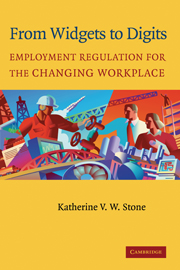Book contents
- Frontmatter
- Contents
- Preface
- Introduction
- PART I LABOR RELATIONS REGIMES OF THE PAST
- PART II THE DIGITAL WORKPLACE
- PART III IMPLICATIONS OF DIGITAL JOB STRUCTURES FOR LABOR AND EMPLOYMENT LAW
- 6 Implications of the New Workplace for Labor and Employment Regulation
- 7 Disputes over Ownership of Human Capital
- 8 The Changing Nature of Employment Discrimination
- 9 Unionism in the Boundaryless Workplace
- 10 Reimagining Employee Representation
- PART IV SOCIAL JUSTICE IN THE DIGITAL ERA
- Summary and Conclusion
- Index
6 - Implications of the New Workplace for Labor and Employment Regulation
Published online by Cambridge University Press: 14 January 2010
- Frontmatter
- Contents
- Preface
- Introduction
- PART I LABOR RELATIONS REGIMES OF THE PAST
- PART II THE DIGITAL WORKPLACE
- PART III IMPLICATIONS OF DIGITAL JOB STRUCTURES FOR LABOR AND EMPLOYMENT LAW
- 6 Implications of the New Workplace for Labor and Employment Regulation
- 7 Disputes over Ownership of Human Capital
- 8 The Changing Nature of Employment Discrimination
- 9 Unionism in the Boundaryless Workplace
- 10 Reimagining Employee Representation
- PART IV SOCIAL JUSTICE IN THE DIGITAL ERA
- Summary and Conclusion
- Index
Summary
The new employment system described in Part II has many implications for labor and employment regulation. The basic framework of today's labor and employment law originated in the New Deal period, when President Franklin D. Roosevelt and a Democratic Congress took affirmative steps to assist American workers who had been devastated by the Great Depression. In that decade, three significant labor statutes were enacted and two major Supreme Court opinions rendered that together established a framework for governing labor relations that persists to this day. This framework was based upon the employment relationship that prevailed during the New Deal period – the Taylorist job structures of the internal labor market. It was a framework that was appropriate to long-term employment relationships in stable work environments, but it is a framework that it is becoming increasingly out of date.
The New Deal Labor Law Framework
In 1932, Congress enacted the Norris-La Guardia Act, which declared it to be the public policy of the United States to support workers' rights to organize and engage in collective bargaining. The act made it unlawful for federal courts to issue injunctions in many types of labor disputes. In 1935, the National Labor Relations Act (NLRA) was passed by Congress, giving workers an enforceable right to engage in concerted action for mutual aid and protection, to organize unions of their own choosing, and to engage in collective bargaining. The NLRA also established an administrative agency, the National Labor Relations Board (NLRB), to enforce those rights.
- Type
- Chapter
- Information
- From Widgets to DigitsEmployment Regulation for the Changing Workplace, pp. 119 - 126Publisher: Cambridge University PressPrint publication year: 2004



